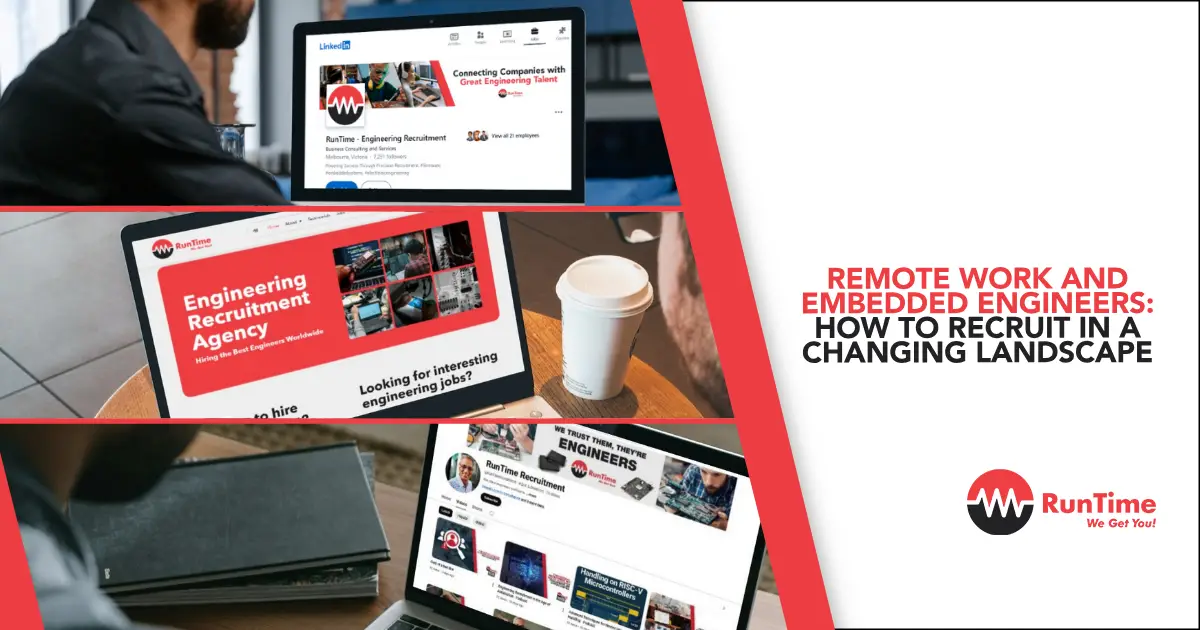The landscape of work is rapidly evolving, with remote work becoming increasingly prevalent. Amidst this shift, the demand for specialized talent like embedded engineers remains high. Recruitment in this changing environment poses unique challenges and opportunities for companies seeking to build their teams. The intersection of remote work and the need for embedded engineers requires a strategic approach to talent acquisition.
This article delves into the intricacies of recruiting embedded engineers in a remote work setting, exploring best practices, tools, and strategies for effectively attracting and retaining top engineering talent.
By understanding the nuances of remote work and the specific requirements of embedded engineering roles, companies can optimize their recruitment processes and build high-performing, distributed teams. Join us on this journey as we navigate the dynamic landscape of remote work and delve into the world of hiring embedded engineers.
The Role of Recruitment Agencies in a Remote Work Era
In the current landscape of remote work, the role of recruitment agencies has become increasingly crucial in sourcing top talent for engineering roles. With the shift towards remote work environments, organizations are looking for skilled professionals who not only possess the technical expertise required for the job but also fit seamlessly into their company culture and work dynamics. RunTime, a leading recruitment agency, has recognized this shift and adapted its candidate sourcing strategies to meet the evolving demands of the market.
RunTime’s approach to candidate sourcing is multifaceted, leveraging various channels to ensure a diverse pool of highly qualified candidates. By employing strategies such as content marketing, utilizing social networks, posting on job boards, and tapping into their own vetted candidate database, RunTime can present organizations with a curated selection of candidates that not only meet the technical requirements but also align with the cultural nuances of the company.
What sets RunTime apart from traditional recruitment methods is their personalized services that delve deep into understanding a company’s culture, team dynamics, and ongoing projects. This emphasis on cultural fit, in addition to technical proficiency, enables RunTime to offer a more holistic recruitment approach that resonates well in a remote work setting. By prioritizing cultural alignment, RunTime ensures that the candidates presented to organizations not only have the necessary skills but also integrate smoothly into the existing team structure.
Furthermore, RunTime goes beyond just matching candidates with organizations. They provide valuable support services such as pre-interview coaching, salary negotiations, and resume guidance, aiming to facilitate a seamless recruitment process for both candidates and hiring organizations. This comprehensive support ensures that the recruitment process is not just efficient but also results in long-term placements that benefit both parties.
In addition to their recruitment services, RunTime’s dedication to fostering a family-like culture and boasting high staff retention rates speaks volumes about their commitment to building lasting relationships with both candidates and organizations. This dedication to maintaining strong partnerships underscores RunTime as a trusted recruitment partner within the engineering industry.
As the remote work landscape continues to evolve, recruitment agencies like RunTime play a pivotal role in bridging the gap between organizations and top talent. Their tailored services, focus on cultural alignment, and commitment to ongoing support position them as frontrunners in the realm of recruitment agencies navigating the challenges and opportunities presented by remote work.
Expertise of RunTime in Recruiting for Embedded Industries
Specialization in Recruiting for Diverse Embedded Sectors.
RunTime has established itself as a premier recruitment agency with a remarkable specialization in sourcing talent for a diverse range of embedded sectors. The company’s expertise extends to industries such as medical devices, transportation systems, Internet of Things (IoT) technologies, aerospace, automotive, and more. By honing in on these specialized areas, RunTime ensures that both candidates and clients benefit from industry-specific knowledge and insights, ultimately facilitating successful placements that align with the unique requirements of each sector.
Roles Typically Recruited by RunTime within Embedded Industries.
Within the dynamic landscape of embedded industries, RunTime excels in identifying and securing top talent for critical roles essential for the development and implementation of embedded systems. Some of the key positions frequently filled by RunTime include Embedded Software Engineers, Hardware Engineers, Firmware Developers, Embedded Systems Architects, Embedded Systems Testers, Systems Integration Engineers, and IoT Solution Architects. These roles are pivotal in driving innovation, ensuring product quality, and maintaining the seamless operation of embedded systems in various applications.
In-Demand Skills for Positions in Embedded Industries.
To thrive in the competitive realm of embedded industries, professionals must possess a diverse skill set that goes beyond technical proficiency. In addition to mastery of programming languages like C, C++, and Python, candidates should demonstrate a deep understanding of hardware-software co-design principles, familiarity with real-time operating systems (RTOS) such as FreeRTOS and QNX, experience in debugging complex embedded systems, knowledge of industry-standard communication protocols like SPI, I2C, and UART, and the ability to work effectively in cross-functional teams. Moreover, strong problem-solving capabilities, adaptability to evolving technologies, and excellent communication skills are indispensable traits for success in embedded roles.
RunTime’s Strategic Approach to Recruitment in Embedded Industries.
What sets RunTime apart in the realm of embedded industry recruitment is its strategic approach to talent acquisition. The company leverages its extensive network, industry partnerships, and deep understanding of client needs to deliver tailored recruitment solutions that match top talent with the right opportunities. Through rigorous candidate assessments, technical evaluations, and cultural fit analyses, RunTime ensures that every placement is a strategic investment for both clients and candidates, fostering long-term success and growth within the embedded industries.
The Future of Embedded Industry Recruitment.
As technology continues to advance and embedded systems play an increasingly integral role in various sectors, the demand for skilled professionals in embedded industries is poised to grow. In this rapidly evolving landscape, RunTime remains at the forefront of recruitment innovation, continuously adapting its strategies to meet the evolving needs of clients and candidates. By staying abreast of emerging technologies, industry trends, and talent requirements, RunTime is well-positioned to lead the way in connecting top talent with rewarding opportunities in the ever-expanding realm of embedded industries.
Challenges Faced by Embedded Engineers in a Remote Work Environment
In the dynamic landscape of electronics design, embedded engineers working remotely encounter a myriad of challenges that demand innovative solutions to ensure the optimization of cost, size, and performance. One of the primary obstacles faced by these professionals is the intricacy of collaborating effectively on hardware and software integration in a virtual setting. The absence of physical proximity poses a unique challenge, making tasks coordination and issue resolution more intricate. Furthermore, the unavailability of physical hardware for testing presents a significant hurdle. Remote engineers often grapple with the reliance on in-person setups and equipment, making remote testing a formidable barrier.
Noteworthy is the critical aspect of maintaining seamless communication with team members, as the lack of face-to-face interaction can lead to delays and misconceptions in project development. To combat these challenges, embedded engineers can deploy various strategies. Embracing tools for virtual hardware simulation can furnish a simulated environment for testing and integration, bridging the spatial gap effectively. Robust communication channels like video conferencing, instant messaging, and project management platforms play a pivotal role in enhancing collaboration and information dissemination.
Establishing well-defined project milestones is imperative for tracking progress and ensuring alignment among team members. Clear, achievable goals and timelines instill focus and accountability throughout the project lifecycle. Leveraging their expertise in FPGA development, multi-core processors, data acquisition optimization, ESD protection, PCB design, and FPGA verification equips remote embedded engineers to navigate the challenges of remote work with finesse. By applying their specialized knowledge and skills to surmount obstacles, engineers can optimize electronics design for cost, size, and performance even within a remote work environment.
Moreover, fostering a culture of continuous learning and upskilling is essential for remote embedded engineers to stay abreast of advancements in technology and industry trends. Engaging in virtual workshops, webinars, and online courses can enhance their proficiency and adaptability in a rapidly evolving field. Additionally, promoting a supportive and collaborative team environment through regular virtual team-building activities and knowledge-sharing sessions fosters cohesion and synergy among dispersed team members.
While remote work presents unique challenges for embedded engineers, proactive measures such as embracing innovative tools, fostering effective communication, and leveraging specialized expertise can empower these professionals to excel in optimizing electronics design for cost, size, and performance in a remote work environment.
The Future of Remote Work for Embedded Engineers
Predictions on the Evolving Landscape of Remote Work in the Engineering Sector
In this blog section, we uncover the future of remote work for embedded engineers and delve deeper into the evolving landscape that is reshaping the engineering sector. With the global shift towards remote work, professionals in this field are experiencing a significant transformation in how they collaborate, innovate, and contribute to projects. We explore the key predictions that are driving this change and discuss the implications for the future workforce.
Adoption of New Technologies and Methodologies in Remote Work Settings
In the realm of remote work, the adoption of new technologies and methodologies plays a crucial role in enhancing efficiency, productivity, and collaboration among embedded engineers. From the integration of artificial intelligence and machine learning in design processes to the utilization of virtual reality for remote testing and debugging, the possibilities are endless. By embracing these innovative solutions, engineers can overcome geographical barriers and work seamlessly across borders, fostering a truly global engineering community.
Impact on Recruitment Processes and Industry Dynamics
The widespread acceptance of remote work is revolutionizing traditional recruitment processes and reshaping industry dynamics within the engineering sector. Companies are now tapping into a diverse talent pool from around the world, enabling them to access specialized skills and expertise that may not be locally available. This shift towards a more globalized workforce is not only expanding opportunities for professionals but also challenging organizations to rethink their strategies for talent acquisition, onboarding, and employee engagement. As the boundaries of work continue to blur, it is essential for both employers and employees to adapt to this new paradigm and leverage the benefits it offers for personal growth and organizational success.
Emerging Trends in Remote Work for Embedded Engineers
Beyond the current landscape, emerging trends in remote work for embedded engineers are poised to reshape the industry further. One such trend is the rise of collaborative tools specifically designed for engineering teams operating remotely. These tools facilitate real-time collaboration, version control, and project management, ensuring seamless coordination among team members regardless of their physical locations. Additionally, the adoption of secure communication platforms and virtual meeting solutions is becoming increasingly prevalent to address the need for effective communication and information sharing in virtual work environments.
Challenges and Opportunities in Remote Work
While remote work offers numerous advantages, it also presents unique challenges that engineers must navigate. One major challenge is maintaining a healthy work-life balance when working from home, as the boundaries between professional responsibilities and personal life can become blurred. To address this, companies are exploring innovative approaches such as flexible scheduling, virtual team-building activities, and wellness programs to support the well-being of their remote workforce. Moreover, the shift towards remote work opens up new opportunities for engineers to explore freelance or independent contractor roles, providing them with greater flexibility and autonomy in managing their careers.
Building a Successful Remote Work Team in Embedded Engineering
Remote work has become a norm in today’s digital age, offering both opportunities and challenges for embedded engineering teams. In this blog section, we will delve into the essential strategies for creating a successful remote work team in embedded engineering.
Fostering Collaboration and Innovation:
- Emphasize Clear Communication: Establishing clear channels for communication is vital in remote teams. Utilize messaging platforms, video conferencing, and project management tools to facilitate seamless interactions.
- Encourage Knowledge Sharing: Promote a culture of knowledge sharing among team members. Virtual brainstorming sessions, collaborative document sharing, and regular team meetings can enhance innovation.
Tools and Technologies for Effective Remote Work:
- Version Control Systems: Implement version control systems like Git to manage code repositories efficiently. This ensures that team members can collaborate on code seamlessly.
- Virtual Collaboration Tools: Leverage tools like Slack, Microsoft Teams, or Zoom for real-time communication and collaboration. These platforms enable instant messaging, video calls, and file sharing.
Best Practices for Remote Team Management:
- Establish Clear Goals: Define clear objectives and deliverables for each project. Setting measurable goals helps remote teams stay focused and aligned.
- Regular Check-ins: Conduct regular check-in meetings to track progress, address challenges, and provide support to team members. This fosters a sense of accountability and teamwork.
Challenges in Remote Embedded Engineering Teams:
Remote work in embedded engineering poses unique challenges that require innovative solutions. Issues such as hardware access limitations, debugging difficulties, and maintaining code consistency across distributed team members can impact productivity. Overcoming these challenges necessitates proactive measures like creating virtual hardware labs for testing, implementing remote debugging tools, and enforcing coding standards through automated checks.
Embracing Remote Team Diversity:
Diversity in remote teams brings a wealth of perspectives and experiences, fostering creativity and problem-solving. Encouraging inclusivity, cross-cultural communication, and sensitivity to different work styles can harness the strengths of a diverse remote team. Leveraging diverse skill sets and viewpoints can lead to more robust solutions and innovative approaches in embedded engineering projects.
Building a successful remote work team in embedded engineering requires a multifaceted approach that encompasses effective communication, collaboration tools, project management best practices, and tailored solutions to address unique challenges. By embracing diversity, overcoming technical hurdles, and nurturing a culture of innovation, remote teams can excel in delivering cutting-edge embedded engineering solutions.
The Importance of Upskilling for Remote Embedded Engineers
Remote work has become increasingly prevalent, including for embedded engineers. To thrive in this environment and stay competitive, it is crucial for remote embedded engineers to focus on upskilling and continuous learning. This blog section will delve into effective upskilling strategies tailored for remote embedded engineers.
Identifying Skill Gaps and Opportunities
One of the first steps for remote embedded engineers is to identify their skill gaps and areas for professional growth. This self-assessment will help them understand where they currently stand and what skills they need to develop to advance in their careers. Moreover, utilizing tools like skills matrices and feedback from peers can provide valuable insights into areas that need improvement.
Training Programs and Resources
Fortunately, there are abundant training programs and resources available for enhancing skills in embedded engineering. Online courses, webinars, workshops, and certifications can provide remote engineers with the knowledge and hands-on experience necessary to excel in their roles. Additionally, seeking mentorship from experienced professionals in the field can offer valuable guidance and practical insights, aiding in skill development and career progression.
Continuous Learning Approaches
To remain competitive in the remote work landscape, remote embedded engineers should adopt a mindset of continuous learning. This involves staying updated on the latest industry trends, technologies, and best practices. Engaging in communities, attending virtual conferences, and participating in hackathons are some ways to continuously learn and grow. Furthermore, setting aside dedicated time for self-study and skill refinement, such as through personal projects or contributing to open-source initiatives, can also be highly beneficial.
Networking and Collaboration
Building a strong professional network is essential for remote embedded engineers. Networking can open up opportunities for collaboration, knowledge sharing, and potential career advancements. Leveraging platforms like LinkedIn, participating in online forums, and joining industry-specific groups can facilitate connections with like-minded professionals and experts in the field.
Upskilling Through Innovation and Experimentation
In the fast-paced world of embedded engineering, innovation is key to staying ahead. Remote embedded engineers can explore new technologies, experiment with different tools and methodologies, and take on challenging projects to broaden their skill set and adaptability. By embracing a mindset of innovation and experimentation, engineers can not only upskill but also contribute fresh ideas and solutions to their projects.
Balancing Technical Skills and Soft Skills
While technical proficiency is essential for remote embedded engineers, soft skills are equally important. Communication, problem-solving, teamwork, and adaptability are vital skills that can enhance an engineer’s effectiveness in a remote setting. Engaging in workshops or courses that focus on soft skill development, practicing effective communication in virtual team environments, and seeking feedback from colleagues can help remote engineers strike a balance between technical expertise and interpersonal skills.
Measuring Progress and Setting Goals
Setting measurable goals and tracking progress is fundamental to any upskilling journey. Remote embedded engineers can establish short-term and long-term goals related to skill acquisition, project completion, or career advancement. Regularly assessing one’s progress, celebrating achievements, and adjusting goals as needed can provide a sense of direction and motivation to continue upskilling efforts.
Remote embedded engineers have a wealth of opportunities to enhance their skills, adapt to the evolving industry landscape, and advance in their careers through strategic upskilling strategies. By investing in continuous learning, leveraging available resources, fostering professional relationships, embracing innovation, honing both technical and soft skills, and setting clear goals, remote engineers can position themselves for success in the dynamic field of embedded engineering.
Conclusion
As the landscape of work continues to evolve towards remote setups, recruiting embedded engineers requires a shift in strategies to attract top talent. Companies must prioritize flexibility, offer robust remote work infrastructure, and cultivate a strong employer brand to effectively recruit and retain embedded engineers in this changing environment. Embracing remote work opportunities can not only expand the talent pool but also lead to increased efficiency and innovation within engineering teams.









